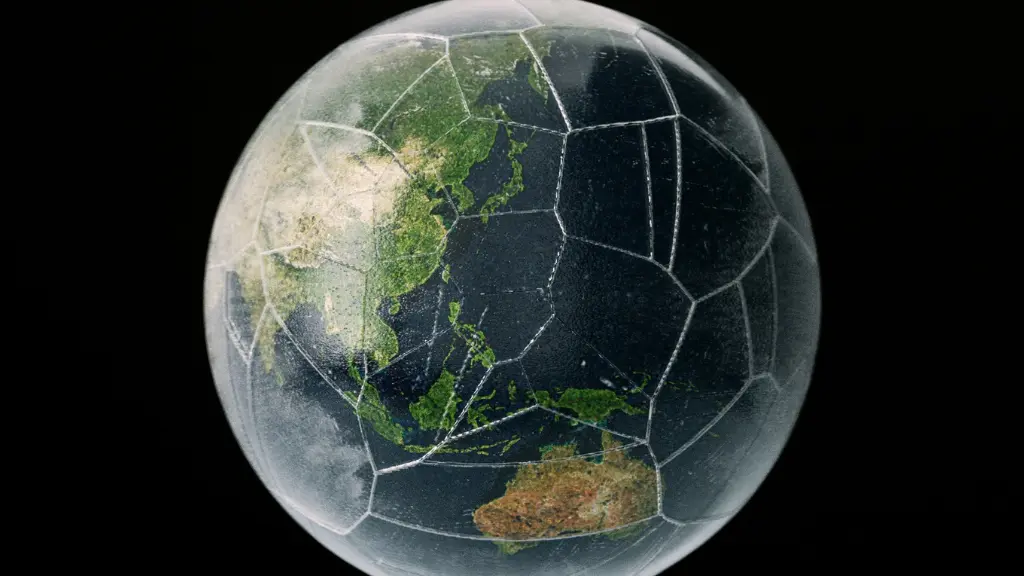

Ядрото на Земята е очарователна и мистериозна част от нашата планета. Като самият център на земно ядро, той играе решаваща роля в цялостната структура и поведение на планетата. Ядрото се състои от две отделни части: вътрешно ядро и външно ядро.
Вътрешното ядро е твърда сфера, съставена от желязо и никел, с диаметър приблизително 1200 километра. Той е заобиколен от външното ядро, което е слой от разтопен метал с дебелина около 2300 километра. Заедно тези два слоя съставляват около 15% от общия обем на Земята. Ядрото също е невероятно горещо, като температурите достигат до 6000 градуса по Целзий в центъра.
Учените изучават ядрото на Земята от десетилетия, но все още има много неща, които остават неизвестни. Последният напредък в технологиите обаче позволи на изследователите да разберат по-добре този мистериозен регион. В тази статия ще изследвам ядрото на Земята по-подробно, включително неговия състав, поведение и ролята, която играе при оформянето на нашата планета.

Ядрото на Земята е централната част на нашата планета, разположена под мантията и кората. Той е разделен на два слоя: твърдо вътрешно ядро и течно външно ядро. Съставът на земното ядро е обект на голям интерес за учените, тъй като ни помага да разберем формирането и еволюцията на нашата планета.
Смята се, че химическият състав на ядрото на Земята е предимно желязо (Fe) и никел (Ni). Тези елементи съставляват повече от 80% от масата на ядрото, с по-малки количества други елементи като сяра (S), кислород (O) и силиций (Si). Точният състав на ядрото е трудно да се определи, тъй като е невъзможно да се наблюдава директно. Въпреки това учените са успели да направят изводи за състава на ядрото въз основа на сеизмични данни и експерименти.
Смята се, че твърдото вътрешно ядро на Земята е съставено предимно от желязо, с по-малки количества никел и други елементи. Смята се, че има радиус от приблизително 1220 километра и температура около 5000 градуса по Целзий. Въпреки високата си температура, вътрешното ядро остава твърдо поради огромното налягане, под което е.
Течното външно ядро на земното ядро също е основно съставено от желязо и никел, но съдържа и по-леки елементи като сяра и кислород. Смята се, че има дебелина приблизително 2300 километра и температура около 4000 градуса по Целзий. Магнитното поле на Земята, което ни предпазва от опасната слънчева радиация, се генерира от външното ядро.
В заключение, съставът на земно ядро се състои основно от желязо и никел, с по-малки количества други елементи. Твърдото вътрешно ядро и течното външно ядро играят важна роля в геологията на Земята и полето на земното магнитно ядро. Необходими са допълнителни изследвания, за да се разбере напълно съставът и поведението на земното ядро.

Като геофизик винаги съм бил очарован от динамиката на земното ядро. Ядрото е сложна система, която се състои от два отделни слоя, вътрешното ядро и външното ядро. В този раздел ще изследвам движенията и преноса на топлина в ядрото.
Ядрото на Земята е постоянно в движение. Ядрото на земното магнитно поле, което ни предпазва от опасна слънчева радиация, се генерира от външното ядро. Движението на външното ядро се задвижва от топлината, генерирана от вътрешното ядро и охлаждането на външното ядро в горната част. Това движение е известно като конвекция.
Въртенето на Земята също играе ключова роля в движението на ядрото. Ефектът на Кориолис кара конвекционните токове да се въртят по посока на часовниковата стрелка в северното полукълбо и обратно на часовниковата стрелка в южното полукълбо. Това въртене създава динамо ефект, който генерира магнитното поле на Земята.
Вътрешното ядро, от друга страна, се върти независимо от външното ядро. Въртенето на вътрешното ядро е малко по-бързо от въртенето на земната повърхност, завършвайки пълно завъртане на всеки 24 часа. Това въртене генерира малко количество енергия, за което се смята, че е отговорно за поддържането на магнитното поле на ядрото.
Ядрото на науката за Земята е изключително горещо, като температурите достигат до 6000 градуса по Целзий. Топлината се генерира от разпадането на радиоактивни изотопи и остатъчната топлина от образуването на Земята. След това топлината се прехвърля от вътрешното ядро към външното ядро чрез проводимост.
Охлаждането на външната сърцевина в горната част създава температурен градиент, който задвижва конвекционните потоци. Докато горещият материал се издига, той се охлажда и потъва обратно надолу, създавайки непрекъснат цикъл на пренос на топлина.
В заключение, динамиката на земното ядро е сложна система от движения и пренос на топлина. Движенията на ядрото се задвижват от конвекцията и въртенето на Земята, докато топлината се генерира от разпадането на радиоактивни изотопи и остатъчната топлина от образуването на Земята. Разбирането на динамиката на ядрото е от решаващо значение за разбирането на магнитното поле на Земята и процесите, които оформят нашата планета.

Като учен по Земята намирам изследването на магнитното поле на Земята за завладяващо. Магнитното поле е важен аспект на нашата планета и играе решаваща роля в нашето ежедневие. В този раздел ще обсъдя ролята на земното ядро в генерирането и поддържането на магнитното поле.
Магнитното поле на Земята възниква от движението на разтопено желязо във външното ядро. Външното ядро е слой от течно желязо, който обгражда твърдото вътрешно ядро. Движението на разтопеното желязо генерира електрически токове, които от своя страна произвеждат магнитното поле.
Магнитното поле не е статично, а постоянно се променя. Магнитните полюси могат да се движат и дори да обръщат полярността с течение на времето. Тези промени се дължат на сложната динамика на земното ядро и неговите взаимодействия с мантията и кората.
Геомагнитните обръщания са най-драматичните промени в магнитното поле на Земята. По време на обръщане магнитното поле отслабва и магнитните полюси разменят местата си. Последното обръщане се е случило преди около 780 000 години и учените все още се опитват да разберат механизмите, които причиняват тези обръщания.
Една теория е, че обръщанията са причинени от промени в потока на разтопено желязо във външното ядро. Тъй като потокът се променя, магнитното поле отслабва и в крайна сметка се обръща. Друга теория е, че обръщанията са причинени от взаимодействията между ядрото и мантията.
В заключение, магнитното поле на земното ядро е сложна и динамична система, която се генерира и поддържа от движението на разтопено желязо във външното ядро. Магнитното поле играе решаваща роля в нашето ежедневие, от насочването на компаси до защитата ни от вредната слънчева радиация. Разбирането на ролята на ядрото в магнетизма на Земята е важна област на изследване за земните учени.

Като учен по Земята намирам изследването на земното ядро за завладяващо. Ядрото на Земята е най-вътрешната част на нашата планета, състояща се от твърдо вътрешно ядро и течно външно ядро. Ядрото съставлява около 15% от обема на Земята и 32% от нейната маса. Въпреки важността си, изучаването на ядрото на Земята е предизвикателна задача поради неговата недостъпност.
Един от основните методи, използвани за изследване на земното ядро, е анализът на сеизмичните вълни. Сеизмичните вълни са вълни от енергия, които преминават през вътрешността на Земята и могат да предоставят ценна информация за свойствата на земното ядро. Чрез анализиране на времето за пътуване и амплитудите на сеизмичните вълни учените могат да направят извод за плътността, температурата и състава на земното ядро.
Друг метод, използван за изследване на земното ядро, е изчислителната симулация. Това включва използването на компютърни модели за симулиране на поведението на земното ядро при различни условия. Чрез промяна на параметри като температура, налягане и състав учените могат да получат представа за динамиката на земното ядро и как то влияе върху магнитното поле на Земята.
В заключение, изучаването на земното ядро е сложна и предизвикателна задача, която изисква използването на множество методи и техники. Чрез анализ на сеизмични вълни и изчислителна симулация учените придобиват по-добро разбиране за ядрото на Земята и неговата роля в оформянето на планетата, на която живеем.

Като човек, който е изучавал земното ядро, мога уверено да кажа, че ядрото е една от най-очарователните и важни части на нашата планета. То се намира в самия център на Земята и се състои от две ядра в земните слоеве: вътрешно ядро и външно ядро.
Границата между земното ядро и мантията е известна като граница ядро-мантия. Намира се на приблизително 2900 километра под повърхността на Земята. Границата е белязана от рязко увеличаване на плътността и промяна в поведението на сеизмичните вълни, които преминават през нея.
Границата ядро-мантия е много важна област на изследване за геолози и сеизмолози. Смята се, че границата играе решаваща роля в движението на тектоничните плочи и формирането на вулканична дейност. Смята се също, че границата е отговорна за генерирането на магнитното поле на Земята.
Взаимодействията между ядрото и кората също са много важни. Топлината на земното ядро задвижва движението на тектоничните плочи, което от своя страна оформя земната повърхност. Ядрото също играе роля при формирането на планините, тъй като движението на тектоничните плочи може да доведе до огъване и сгъване на кората.
В допълнение, магнитното поле на земното ядро е отговорно за защитата на Земята от вредните ефекти на слънчевия вятър и космическата радиация. Без това магнитно поле животът на Земята би бил много по-труден, ако не и невъзможен.
Като цяло земното ядро е важна част от вътрешността на Земята. Неговите взаимодействия с мантията и кората са отговорни за много от геоложките процеси, които оформят нашата планета. Чрез непрекъснато проучване и изследване можем да придобием по-добро разбиране за ядрото и неговата роля в историята и бъдещето на нашата планета.

Като човек, който е изучавал ядрото на ядрото на планетата Земя, мога уверено да кажа, че то има значително влияние върху повърхностните явления. В този раздел ще обсъдя два основни начина, по които ядрото влияе на земната повърхност: вулканична активност и тектонични движения.
Земното ядро играе решаваща роля в генерирането на вулканична дейност. Магмата, която е разтопена скала, намираща се под повърхността на Земята, се създава от топенето на скали в мантията и кората. Това топене се причинява от високите температури и налягания, които съществуват дълбоко в Земята, които в крайна сметка се генерират от топлината, която се отделя от ядрото.
Земното ядро също влияе върху състава на магмата. Ядрото се състои предимно от желязо и никел и се смята, че тези елементи са източникът на желязото и никела, които се намират в магмата. Освен това, магнитното поле на ядрото може да повлияе на движението на магмата, което от своя страна може да повлияе на местоположението и интензивността на вулканичните изригвания.
Земното ядро също играе значителна роля в тектонските движения, които са движенията на плочите на земната кора. Смята се, че топлината на ядрото е основният двигател на тези движения, тъй като причинява конвекционни течения в мантията. Тези течения от своя страна задвижват движението на плочите на кората.
Земното ядро също влияе върху състава и здравината на коровите плочи. Топлината, генерирана от ядрото, кара скалите в мантията и кората да бъдат по-пластични, което означава, че те се деформират по-лесно. Това може да доведе до образуване на разломи и фрактури в земната кора, което в крайна сметка може да доведе до земетресения.
В заключение, ядрото на земното ядро има значително влияние върху повърхностните явления, по-специално върху вулканичната активност и тектоничните движения. Разбирането на ролята на ядрото в тези процеси е от решаващо значение за прогнозиране и смекчаване на ефектите от природни бедствия като вулканични изригвания и земетресения.

Като геолог намирам земното ядро за завладяваща тема. Той не само засяга магнитното поле на планетата, но също така оказва влияние върху океаните. В този раздел ще обсъдя връзката между ядрото на Земята и океаните.
Земното ядро генерира топлина, която се пренася към повърхността чрез конвекция. Тази топлина задвижва термохалинната циркулация, която е отговорна за движението на водата в океаните. Термохалинната циркулация се задвижва от разликите в температурата и солеността, които създават градиенти на плътност в океана.
Топлата вода от екватора тече към полюсите, където се охлажда и потъва на дъното на океана. След това тази студена вода се връща обратно към екватора, завършвайки циркулацията. Този процес играе решаваща роля в регулирането на климата на земното ядро чрез разпределяне на топлина около планетата.
Ядрото на Земята също оказва влияние върху промените в морското равнище. Гравитационното привличане на Луната и Слънцето причинява приливи и отливи, които могат да бъдат повлияни от промените в магнитното поле на Земята. Магнитното поле се генерира от движението на разтопено желязо в земното ядро, което може да бъде повлияно от външни фактори като слънчеви бури.
Промените в морското равнище могат да бъдат причинени и от топенето на ледници и ледени шапки, което се влияе от ядрото на Земята. Топенето на лед може да причини промени в разпределението на масата върху повърхността на земното ядро, което може да повлияе на въртенето и гравитационното поле на планетата.
В заключение, земното ядро играе значителна роля във функционирането на океаните. Термохалинната циркулация и промените на морското ниво са само два примера за сложната връзка между ядрото на Земята и океаните. Като геолог намирам тази връзка за очарователна тема за по-нататъшно изследване.

Като изследовател в основната наука за Земята, аз съм развълнуван от бъдещите възможности за изследване и открития. Все още има толкова много неща, които не знаем за вътрешното функциониране на нашата планета и аз вярвам, че продължаващите изследвания и изследвания ще доведат до нови прозрения и по-дълбоко разбиране на ядрото на Земята.
Една област от особен интерес е изследването на сеизмичните вълни. Като анализираме начина, по който сеизмичните вълни преминават през земното ядро, можем да получим ценна информация за състава и структурата на ядрото. Продължаващите изследвания в тази област могат да доведат до нови открития за свойствата на ядрото и процесите, които протичат в него.
Друг обещаващ път за бъдещи изследвания е използването на компютърно моделиране и симулация. Създавайки подробни модели на земното ядро, можем да симулираме поведението на различни материали и да тестваме различни хипотези за процесите в ядрото. Този подход вече даде някои вълнуващи резултати и вярвам, че продължаващите инвестиции в тази област ще доведат до още по-големи пробиви.
Освен това вярвам, че има още много да се научи от директното изследване на земното ядро. Въпреки че това е обезсърчаваща задача, възникват нови технологии и техники, които могат да я направят възможна. Например, разработването на модерни сондажни техники и материали може да ни позволи да проникнем по-дълбоко в земната кора и да достигнем ядрото. По същия начин напредъкът в роботиката и дистанционното наблюдение може да ни позволи да изследваме ядрото, без да навлизаме физически в него.

Като цяло съм оптимист за бъдещето на Земно ядро науката и потенциала за нови открития и прозрения. Продължавайки да инвестираме в изследвания и проучвания, можем да задълбочим разбирането си за нашата планета и силите, които я оформят. Вижте още статии като тази, като щракнете тук: Коул Пармър Антилия: подробен преглед.